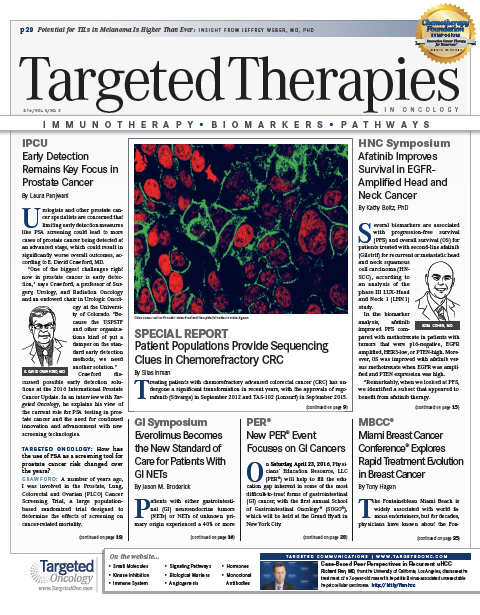Radium-223: Not Just for Palliative Care
Despite what many believe, not all radiopharmaceuticals are just for pain palliation, according to Phillip J. Koo, MD.
“Oncologists need to acknowledge the fact that this radiopharmaceutical improves survival,” he said. “Yes, there are patients who will get pain relief, but the primary endpoint of the ALSYMPCA trial was overall survival, and that is what makes this drug significant.”
In the ALSYMPCA trial, median overall survival (OS) with radium-223 was 14 months compared with 11.2 months with placebo for patients with bone-metastatic castration-resistant prostate cancer (mCRPC). This represented a 30% reduction in the risk of death with the addition of the radiopharmaceutical (HR, 0.70;P= .00185).
In an interview withTargeted Oncologyat the 26th International Prostate Cancer Update (IPCU), Koo discussed the benefits of radium-223 and why he thinks it is time the use of the drug more frequently for the treatment of mCRPC, and potentially other cancers.
TARGETED ONCOLOGY:
What do you envision for the role of radium-223?
KOO:
Radium-223 is a game-changing therapeutic radiopharmaceutical. When it comes to unsealed sources of radiation, this is the first one that has shown an OS benefit. That has never been done with radiopharmaceuticals in the past.
There are also secondary benefits, including delaying time to first skeletal-related event. It is also the first alpha emitter that has been approved. The beauty of an alpha emitter is that it packs a more powerful punch, so it travels a shorter distance. You are actually hitting the disease harder and you are not hitting healthy cells as much, so the complication rates are decreased. Because of those reasons, radium-223 is really making a big impact.
TARGETED ONCOLOGY:
Are there any challenges with radium-223?
KOO:
I think the biggest challenge is that oncologists still see it as a palliative tool. The message is that patients need to get all 6 doses. Oncologists need to figure out a way to get them all 6 doses, if possible. That becomes a lot easier if they are treated earlier in their disease. There are data showing that patients who have lower burden bone disease do better with radium-223, compared with patients who are treated at the end stage of disease.
TARGETED ONCOLOGY:
Why do you think that many oncologists still view it as only a palliative treatment?
KOO:
I think there is this association of radium-223 as a radiopharmaceutical in the past, such as samarium 153 lexidronam. In clinical practice, those aren’t used very often because they do cause significant bone marrow suppression, which prevents oncologists from having the option of giving chemotherapy afterwards, if needed.
I think that is the biggest problem; it is still being put in that same type of class when it really it doesn’t belong there. This is because it’s an alpha emitter and it actually improves overall survival. ALSYMPCA data have shown that radium-223 can be given safely in the prechemotherapy and post-chemotherapy setting.
TARGETED ONCOLOGY:
Do you think there is potential for radium-223 to be used in combination with other agents?
KOO:
To me, this makes a lot of sense because radium-223 is very specific for bone. It targets the bone. It doesn’t target visceral disease, it doesn’t target nodal disease, and it has no known effect to the soft tissues. If you can hit the bone disease using radium-223 and hit soft-tissue disease with drugs like abiraterone (Zytiga) or enzalutamide (Xtandi) simultaneously, you will get a great effect.
If you look at the data from the University of Texas MD Anderson Cancer Center’s series that was published, it showed that use of abiraterone resulted in an improved benefit with the addition of radium-223. These combination therapies make a lot of sense. There are no crossover side effects when the 2 are put together.
There are also trials that have combined radium-223 with chemotherapy. At the Genitourinary Cancers Symposium held earlier this month, there were some preliminary data that showed it was safe, although I do not believe the chemotherapy doses were at the same level as they typically are.
However, this is still promising. There is risk with radium-223 and chemotherapy because there is bone marrow suppression with those drugs, but it is an area that should be interesting to learn more about.
TARGETED ONCOLOGY:
Do you see the use of radium-223 expanding in the future?
KOO:
The great thing about radium-223 is that it has a lot of potential in several diseases. We are currently focusing on prostate cancer, but there are clinical trials up and running looking at it for use in patients with breast cancer. We have a site at our own hospitalthe principal investigator is Christine Fisher, MD, who is using this in patients with breast cancer with bone metastases.
The data on that will be accumulating in the near future. I fully expect it to have similar effects in breast cancer because the mechanism of action is the same; it circulates throughout the body and it localizes the bone. Bone metastases tend to have increased surface area of the bone, so it targets those areas. Whether you are dealing with prostate cancer, breast cancer, thyroid cancer, or even sarcomas, physiologically, it makes a lot of sense.

Novel Approaches Focus on Limiting Toxicity in Older Patients With ALL
April 22nd 2024The major challenges for clinicians treating older patients with acute lymphoblastic leukemia surround the emergence of resistance to existing therapies and the toxicities associated with current chemotherapies.
Read More
Ornstein Advises on Starting Dose and Management of Lenvatinib in RCC
April 21st 2024During a Case-Based Roundtable® event, Moshe Ornstein, MD, MA, provided guidance on dosing and toxicity concerns in a patient treated with lenvatinib plus pembrolizumab for advanced renal cell carcinoma.
Read More
Rugo Surveys Peers on Treatment After Metastatic Relapse of HR+, HER2– Breast Cancer
April 20th 2024During a Case-Based Roundtable® event, Hope S. Rugo, MD, FASCO, moderated a discussion on treatment options for a patient whose breast cancer recurred several years after adjuvant therapy.
Read More